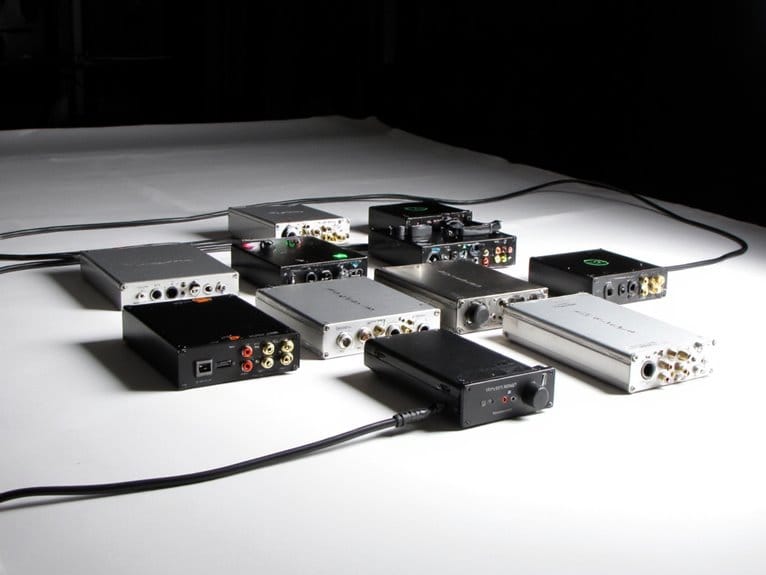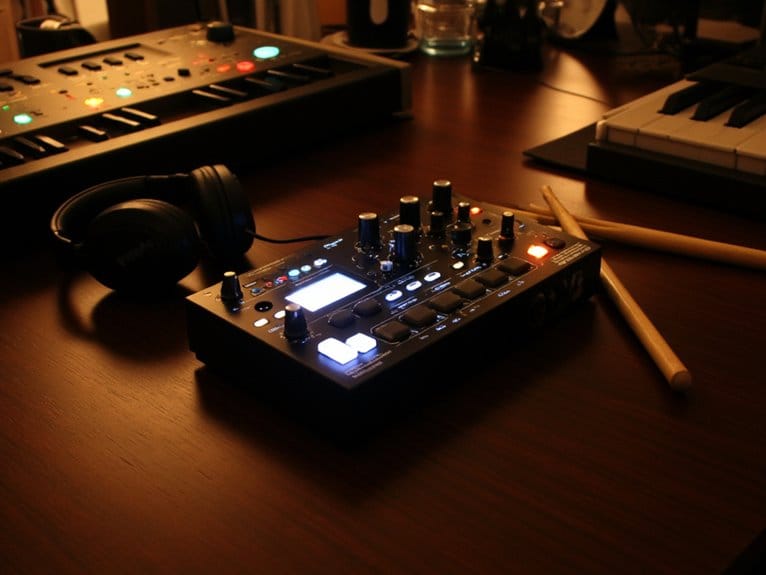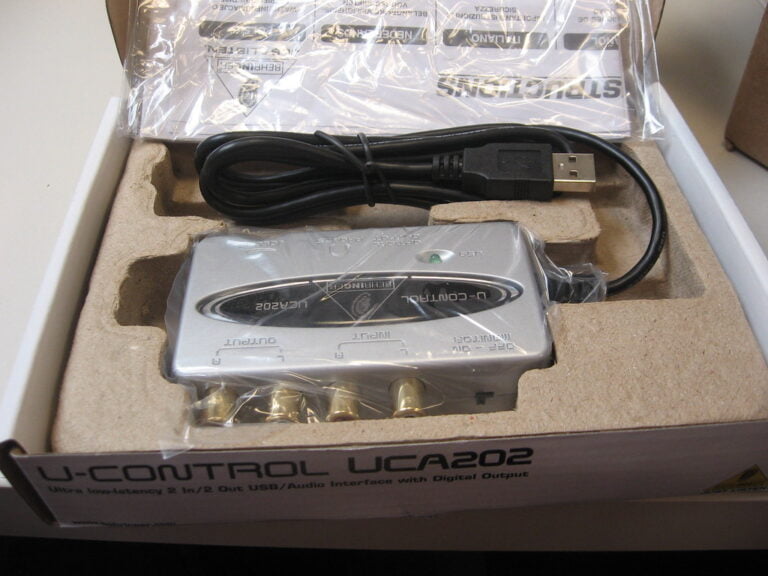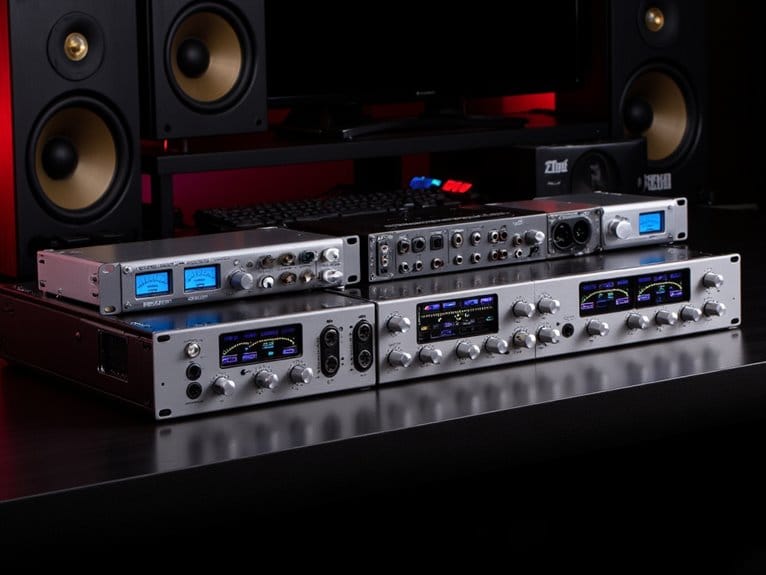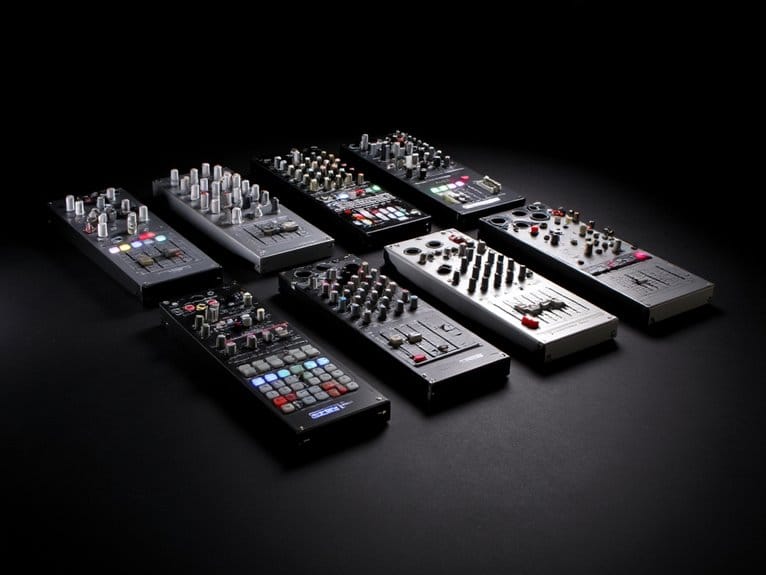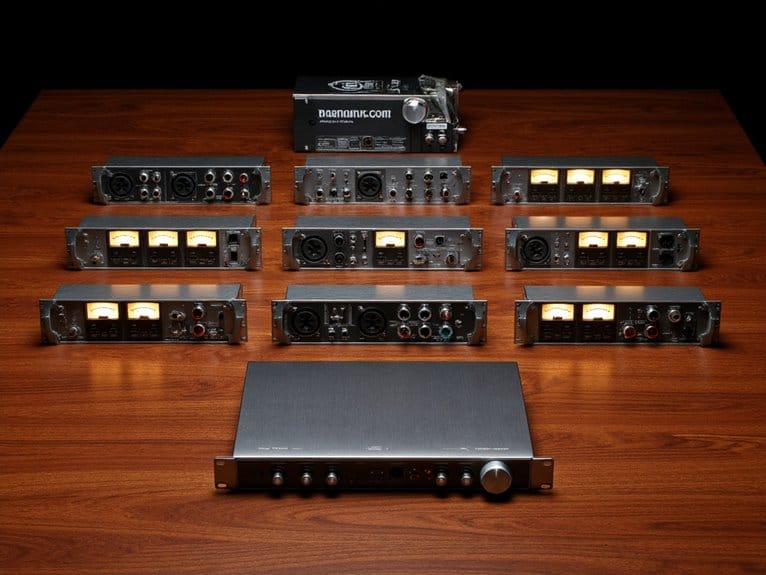10 Best Podcast Audio Interface
After testing dozens of interfaces, I recommend the Focusrite Scarlett 2i2 4th Gen for most podcasters, offering 120dB dynamic range with Auto Gain technology that prevents clipping disasters. The FIFINE AmpliGame SC3 delivers surprising quality at budget prices with 48V phantom power, while the Zoom PodTrak P4‘s four inputs and mix-minus functionality excel for interview-heavy shows. MAONO’s MaonoCaster E2 Gen2 provides dual XLR inputs with customizable effects, and their PS22 Lite offers 24-bit/192kHz recording. Below, I’ll break down each option’s strengths and limitations.
We are supported by our audience. When you purchase through links on our site, we may earn an affiliate commission, at no extra cost for you. Learn more.
Notable Insights
- Focusrite Scarlett 2i2 4th Gen offers professional 120dB dynamic range with Auto Gain technology, ideal for beginner podcasters.
- Zoom PodTrak P4 provides four microphone inputs with battery power and mix-minus functionality, perfect for portable interview recording.
- FIFINE Gaming Audio Mixer delivers affordable XLR support with 48V phantom power and customizable sound effects for content creators.
- MAONO MaonoCaster E2 Gen2 features dual XLR inputs, Bluetooth connectivity, and custom sound effects with excellent streaming software compatibility.
- Consider input channel requirements, audio quality specifications, budget constraints, and scalability needs when selecting your podcast audio interface.
Focusrite Scarlett 2i2 4th Gen USB Audio Interface for Recording

The Focusrite Scarlett 2i2 4th Gen stands out as the best choice for podcasters who demand professional audio quality without the complexity of larger studio setups, combining studio-grade 120dB dynamic range with user-friendly features like Auto Gain and Clip Safe technology. You’ll appreciate how this interface utilizes the same converters found in Focusrite’s flagship studio equipment, delivering genuinely professional sound quality that I’ve personally witnessed transform amateur recordings into polished productions. The Air mode feature adds harmonic richness to vocals, while the included recording software and plugin collection provide everything you need for complete podcast production, eliminating the guesswork from audio optimization.
Best For: Podcasters and content creators who need professional studio-quality audio recording with beginner-friendly features and comprehensive software included.
Pros:
- Studio-grade 120dB dynamic range with the same converters used in Focusrite’s flagship interfaces
- Auto Gain and Clip Safe technology automatically optimize recording levels and prevent audio clipping
- Includes comprehensive recording software and industry-leading plugins for complete production workflow
Cons:
- Limited to only 2 inputs, which may not be sufficient for larger podcast setups or multi-guest recordings
- USB-powered interface may have limitations compared to dedicated power supplies for demanding professional applications
- Air mode enhancement may not suit all vocal types or recording preferences
FIFINE Gaming Audio Mixer with XLR Microphone Interface (AmpliGame SC3)

New content creators who want professional XLR microphone capabilities without breaking the bank will find their perfect match in the FIFINE Gaming Audio Mixer SC3, a compact streaming powerhouse that bridges the gap between amateur USB setups and expensive professional equipment. You’ll get four individual channel controls for microphone, line input, headphones, and line output, plus built-in 48V phantom power for condenser mics. The SC3 delivers customizable sound effects, six voice-changing modes, and twelve auto-tune options, while RGB lighting adds visual flair to your streaming setup. Though it’s primarily plastic construction and lacks Bluetooth connectivity, this plug-and-play mixer offers reliable performance for podcasters seeking professional audio quality at an entry-level price point.
Best For: New content creators and podcasters who want to upgrade from USB microphones to professional XLR setups without spending a fortune on high-end mixing equipment.
Pros:
- Built-in 48V phantom power and XLR input enables use of professional condenser microphones at an affordable price point
- Multiple creative features including customizable sound effects, six voice-changing modes, and twelve auto-tune options for engaging content
- Plug-and-play compatibility with both Mac and Windows systems makes setup simple for beginners
Cons:
- Primarily plastic construction may feel less durable compared to higher-end mixers with metal builds
- Lacks modern connectivity features like Bluetooth and advanced functions like sidechain support
- Not compatible with USB microphones, limiting flexibility for creators who want to use both XLR and USB mics
G10 Podcast Equipment Bundle with Audio Interface & Cardioid P15 Mic
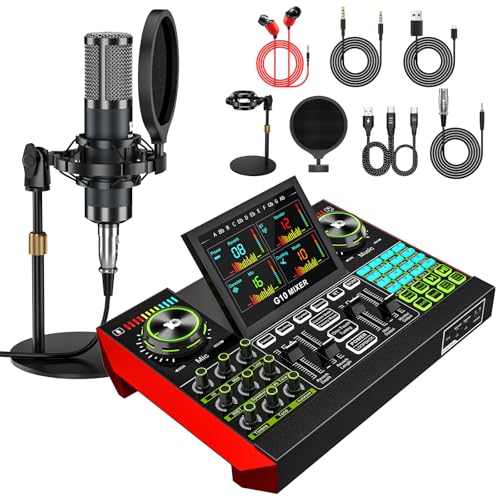
Content creators who’ve grown tired of wrestling with complex audio setups will find the G10 Podcast Equipment Bundle delivers professional-grade sound without the technical headaches that typically plague recording enthusiasts. You’ll appreciate the 4.5-inch adjustable LCD display, which provides real-time visual feedback while managing your audio levels, reverb settings, and auto-tune adjustments. The dual DSP processors handle heavy lifting with five reverb modes, twelve-step auto-tune, and thorough tone controls for treble, mid-range, and bass frequencies. What sets this interface apart is its ability to save nineteen different voice modes, eliminating repetitive configuration during live streams or recording sessions.
Best For: Content creators, podcasters, and live streamers who want professional-quality audio recording with simplified setup and real-time control features.
Pros:
- All-in-one solution with intuitive 4.5-inch LCD display for real-time audio monitoring and control
- Advanced audio processing with dual DSP processors, 5 reverb modes, 12-step auto-tune, and comprehensive tone controls
- Time-saving preset functionality that allows saving 19 different voice modes for quick switching during live streams
Cons:
- May be overkill for basic recording needs or beginners who don’t require advanced audio processing features
- The 4.5-inch screen and multiple controls could overwhelm users who prefer simpler, minimal interfaces
- Portability claims may be limited by the need to carry additional equipment like microphones and cables for full functionality
PUPGSIS Gaming Audio Mixer, Audio Interface for PC/Podcast/Streaming

Gaming streamers and podcasters who need professional-grade audio without breaking the bank will find the PUPGSIS Gaming Audio Mixer particularly compelling, as it combines 48V phantom power for XLR microphones with intuitive channel controls that simplify complex audio management. You’ll appreciate the four volume faders controlling Mic 1, Mic 2/headset, Aux/Bluetooth, and Line Out channels, which transform what could be frustrating audio juggling into straightforward adjustments. The six voice-changing modes and customizable soundpads let you experiment creatively during streams, while two reverb presets guarantee your voice sounds polished across different scenarios. Zero latency monitoring and one-touch mute functionality prevent those cringe-worthy live mishaps we’ve all experienced.
Best For: Gaming streamers, podcasters, and content creators who want professional XLR microphone support with intuitive controls and creative audio effects without investing in expensive equipment.
Pros:
- Professional 48V phantom power for XLR microphones with clear audio output and zero latency monitoring
- Six voice-changing modes and customizable soundpads provide creative flexibility for engaging content
- Intuitive four-channel volume control system with visual display makes audio management straightforward
Cons:
- Limited to basic reverb presets which may not satisfy users needing advanced audio processing
- Only supports up to three microphone inputs, potentially restricting larger multi-person recording setups
- Lacks detailed specifications about audio quality metrics like frequency response and signal-to-noise ratio
Focusrite Scarlett Solo 3rd Gen USB Audio Interface

The Focusrite Scarlett Solo 3rd Gen stands as a compelling entry point for solo podcasters and content creators who need professional-grade audio without the complexity of multi-input systems, though I’ll admit its single XLR input might leave you wanting more if your show grows. You’ll appreciate the high-performing mic preamp with switchable Air mode, which adds clarity to vocal recordings, while the instrument input accommodates guitars without clipping. Recording at 24-bit/192kHz through low-noise balanced outputs delivers studio-quality results, and the intuitive Gain Halos provide visual feedback-green means you’re good, red means back off. The bundled software suite, including Pro Tools Intro+ and Ableton Live Lite, gives you everything needed to start producing immediately.
Best For: Solo podcasters, content creators, guitarists, and vocalists who need professional studio-quality recording in a simple, single-input interface.
Pros:
- High-performing mic preamp with switchable Air mode delivers exceptional vocal clarity and studio-quality recording up to 24-bit/192kHz
- Intuitive Gain Halos provide instant visual feedback for optimal recording levels, while dual inputs handle both XLR microphones and high-headroom instruments
- Comprehensive software bundle including Pro Tools Intro+, Ableton Live Lite, and FL Studio Producer Edition provides complete production tools out of the box
Cons:
- Single XLR input limits scalability for multi-guest podcasts or expanded recording setups
- Initial setup may require driver installation and audio configuration that could challenge less technical users
- Limited to solo recording applications due to minimal input options compared to multi-channel interfaces
M-Audio M-Track Duo USB Audio Interface for Recording & Podcasting

Podcasters seeking professional audio quality without breaking the bank will find the M-Audio M-Track Duo USB Audio Interface delivers exactly what they need in a surprisingly compact package. At just 12.7 ounces, this USB-powered interface features dual XLR/line/instrument inputs with phantom power, making it compatible with any microphone you’ll throw at it. The 48 kHz audio resolution guarantees your recordings sound crisp, while zero-latency monitoring through stereo outputs and headphone jack keeps you on track during sessions. With over 5,500 customer reviews averaging 4.4 stars, it’s earned its #3 ranking in computer recording interfaces, though some users note requiring higher gain settings for peak performance.
Best For: Podcasters and beginner recording enthusiasts who need a compact, affordable USB audio interface with professional features like dual XLR inputs and phantom power.
Pros:
- Compact and portable design at only 12.7 ounces with USB power for easy setup anywhere
- Dual XLR/line/instrument inputs with phantom power provide versatility for any microphone type
- Zero-latency monitoring with direct input/playback balance control for seamless recording sessions
Cons:
- Requires higher gain settings for optimal performance, which some users find inconvenient
- Plastic build quality may affect long-term durability and stability during use
- Limited to 48 kHz audio resolution compared to higher-end interfaces offering 96 kHz or above
Zoom PodTrak P4 Podcast Recorder with 4 Microphone Inputs

Featuring four microphone inputs and extensive headphone monitoring in a remarkably portable 4.6-ounce package, the Zoom PodTrak P4 excels as an all-in-one solution for content creators who need professional recording capabilities without the complexity of traditional audio interfaces. You’ll appreciate its intuitive controls, which eliminate the typical learning curve associated with audio equipment, while the built-in sound pads and mix-minus functionality enable seamless call-in interviews without feedback issues. Though the plastic construction won’t win durability awards, its battery-powered operation and dual USB-C connectivity provide flexibility that traditional interfaces simply can’t match for mobile recording scenarios.
Best For: Content creators and podcasters who need a portable, user-friendly recording solution for multi-person interviews and remote recording scenarios without the complexity of traditional audio equipment.
Pros:
- Intuitive design with simple controls that require no manual reading, making it accessible for beginners
- Excellent portability at 4.6 ounces with long battery life and dual USB-C connectivity for flexible power options
- Mix-minus functionality and phone input enable seamless call-in interviews without feedback issues
Cons:
- Plastic construction is lightweight but may be vulnerable to damage if dropped
- Lacks direct line outputs, requiring use of headphone outputs which may introduce noise
- Records at 16-bit/44.1 kHz which may not meet higher professional audio standards
MAONO Podcast Equipment Bundle: Audio Interface Mixer (MaonoCaster E2 Gen2)

Budget-conscious content creators who need professional-grade audio without breaking the bank will find their perfect match in the MAONO MaonoCaster E2 Gen2, a complete podcast equipment bundle that packs impressive functionality into an surprisingly affordable package. You’ll appreciate the dual XLR combo inputs with 60dB gain preamps, USB-C connectivity, and built-in 1500mA battery providing eight hours of portable recording time. The interface includes eight customizable sound effect buttons, pitch-changing capabilities, one-touch mute functionality, and real-time monitoring features that streamline your workflow. With Bluetooth support for background music, extensive software compatibility across Mac and Windows platforms, and positive user feedback averaging 4.5 stars, this versatile mixer delivers professional results for podcasting, streaming, and studio recording applications.
Best For: Budget-conscious podcasters, streamers, and content creators who need professional-grade audio quality with portable functionality and customizable sound effects for co-host recording setups.
Pros:
- Dual XLR inputs with 60dB gain preamps and built-in 1500mA battery providing 8 hours of portable recording time
- Eight customizable sound effect buttons with pitch-changing capabilities and one-touch mute functionality for enhanced workflow
- Extensive compatibility across Mac/Windows platforms with Bluetooth support and works with popular streaming software like OBS, Discord, and Zoom
Cons:
- Some users reported minor issues with volume control functionality
- Limited to only two XLR inputs which may restrict larger podcast setups
- Sound effect recording is capped at 20 seconds which may be insufficient for longer audio clips
MAONO USB Audio Interface for PC (PS22 Lite Black)

When you’re seeking professional-grade audio capture without the complexity that intimidates newcomers, the MAONO PS22 Lite Black delivers 24-bit/192kHz resolution alongside foolproof plug-and-play functionality that’ll have you recording within minutes of unboxing. This compact interface packs a 56dB preamp with 48V phantom power, supporting both condenser and dynamic microphones while maintaining compatibility across Mac, Windows, and major DAWs like Pro Tools and Logic Pro. The dedicated instrument input accommodates guitars with adjustable impedance, though some users report occasional crackling issues that typically resolve through driver reinstallation-a minor inconvenience considering the 4.4-star rating from 211 reviewers who appreciate its ergonomic controls and reliable performance for podcasting.
Best For: Recording enthusiasts, podcasters, streamers, and musicians who want professional 24-bit/192kHz audio quality with beginner-friendly plug-and-play setup across multiple devices and DAWs.
Pros:
- High-resolution 24-bit/192kHz audio capture with 56dB preamp and 48V phantom power for professional sound quality
- Excellent compatibility across Mac, Windows, iPads, and major DAWs like Pro Tools, Logic Pro, and Ableton Live
- User-friendly design with plug-and-play functionality, direct monitoring, and ergonomic controls ideal for beginners
Cons:
- Some users experience crackling and popping sounds that require driver reinstallation or device updates to resolve
- Quality control issues suggest inconsistent performance across units
- Plastic construction may lack durability compared to metal alternatives in the same price range
Shure MV7i Smart Microphone with Built-in Audio Interface

The Shure MV7i stands out as the ideal choice for podcasters who want professional-grade audio without the complexity of separate microphones and interfaces, since it combines a high-quality dynamic microphone with a built-in two-channel audio interface in one streamlined package. You’ll appreciate the dual XLR and ¼” inputs that support both mono and stereo recording, while the optimized 50Hz-16kHz frequency response delivers rich vocal reproduction that rivals dedicated studio setups. The Voice Isolation Technology effectively reduces background noise, and Auto Level Mode automatically adjusts gain based on your distance and room dynamics, which honestly makes recording much more forgiving than I expected.
Best For: Podcasters and content creators who want professional-quality audio recording with the convenience of a built-in audio interface and dual-channel capabilities without needing separate equipment.
Pros:
- Combines high-quality dynamic microphone with built-in two-channel audio interface, eliminating need for external equipment
- Voice Isolation Technology and Auto Level Mode provide excellent background noise reduction and automatic gain adjustment
- Dual XLR and ¼” inputs support both mono and stereo recording with +60dB gain and 48v phantom power
Cons:
- Touch-sensitive controls can be overly sensitive and prone to accidental activation
- At 2.3 lbs, the weight may be cumbersome for handheld use or lighter boom arms
- Higher price point compared to basic USB microphones without built-in interface features
Factors to Consider When Choosing a Podcast Audio Interface
When I’m selecting an audio interface for podcasting, I consider five critical factors that directly impact both recording quality and long-term satisfaction with the equipment. The number of input channels you’ll need depends on your show format, whether you’re recording solo content, interviewing guests locally, or capturing multiple hosts simultaneously. Your budget constraints, audio quality specifications, included software bundles, and connectivity options all work together to determine which interface will serve your specific podcasting goals most effectively.
Input Channel Requirements
Before diving into specific technical features, I’ll help you determine how many input channels your podcast setup actually needs, since this fundamental decision affects every other aspect of your interface choice.
For solo podcasters, a single-channel interface works perfectly, but I’d recommend considering at least two channels for future flexibility. If you regularly host guests or co-hosts, you’ll need one dedicated channel per person to maintain individual audio control and quality. Remote interviews through platforms like Riverside or SquadCast still benefit from multiple channels when recording local guests simultaneously.
I’ve found that most podcasters initially underestimate their channel requirements, then realize they need expansion capabilities. Four-channel interfaces offer the sweet spot between functionality and affordability for growing shows, accommodating multiple participants while leaving room for additional microphones or instrument inputs.
Audio Quality Specifications
Once you’ve settled on your channel count, audio quality specifications become your next major consideration, and frankly, this is where marketing numbers can mislead you if you don’t understand what actually matters for podcast production. I focus on three core specs: bit depth, sample rate, and dynamic range. While 24-bit/192kHz sounds impressive on paper, 24-bit/48kHz delivers excellent podcast quality without unnecessary file bloat. The dynamic range matters more than sky-high sample rates-I look for at least 106dB to capture everything from whispers to laughter without distortion. Built-in preamps with phantom power support condenser mics, which I’ve found essential for rich vocal reproduction. Zero-latency monitoring prevents that disorienting delay that’ll throw off your natural speaking rhythm during recordings.
Software Bundle Inclusions
The software bundle that ships with your audio interface can dramatically impact your podcasting workflow, and I’ve learned that these packages often determine whether you’ll hit the ground running or spend weeks hunting down compatible recording software. I prioritize interfaces that include industry-standard DAW applications with extensive mixing and mastering tools, as these eliminate the need for separate software purchases. Many manufacturers bundle proprietary creation suites featuring virtual instruments and effects plugins, which expand your production capabilities beyond basic recording. I always verify DAW compatibility before purchasing, ensuring seamless integration with popular platforms like Pro Tools or Logic. Additionally, I value bundles offering tutorials, sound packs, and royalty-free music, particularly for beginners seeking immediate production enhancement.
Connectivity and Compatibility
Multiple connection options can make or break your podcasting setup, and I’ve discovered that versatility in connectivity often determines whether an audio interface grows with your show or becomes a limiting bottleneck within months. I prioritize units offering XLR inputs for professional microphones, USB connectivity for computer integration, and 3.5mm jacks for auxiliary devices like smartphones or headphones. Phantom power support is non-negotiable when working with condenser microphones, while compatibility across Mac OS, Windows, and popular DAWs guarantees seamless workflow regardless of your setup. Plug-and-play functionality eliminates driver headaches that I’ve wrestled with before, and smartphone compatibility opens doors for remote interviews or mobile recording sessions that can save a struggling episode.
Budget and Value
Budget considerations become the determining factor that separates wishful thinking from actually hitting record, and I’ve watched countless aspiring podcasters either overspend on features they’ll never use or cheap out so drastically that they’re upgrading within months. I recommend setting your budget between $150-300 for most podcasters, as this range delivers essential features like multiple XLR inputs, phantom power, and reliable preamps without unnecessary bells and whistles. Higher-end interfaces from brands like Focusrite, PreSonus, and Zoom retain their resale value better than generic alternatives, making them smarter investments long-term. Don’t overlook bundled software packages either, since many interfaces include recording software, plugins, and sample libraries that would otherwise cost hundreds separately.
Frequently Asked Questions
Can I Use Multiple Audio Interfaces Simultaneously for Larger Podcast Setups?
Yes, I can use multiple audio interfaces simultaneously by connecting them through ADAT, S/PDIF, or using aggregate devices in your DAW. This lets me expand input channels for larger podcast setups with more microphones.
Do Podcast Audio Interfaces Work With Smartphones and Tablets for Mobile Recording?
I can connect many audio interfaces to smartphones and tablets using USB adapters or Lightning connectors. However, I’ll need to check compatibility first since mobile devices have limited power output for larger interfaces.
What’s the Difference Between USB-A and USB-C Connectivity for Podcast Interfaces?
USB-A offers universal compatibility with older devices but requires adapters for modern smartphones. USB-C provides faster data transfer, direct connection to newer devices, and can supply power, making it more versatile for mobile podcasting setups.
How Do I Prevent Audio Latency Issues When Monitoring During Podcast Recording?
I’ll enable direct monitoring on my audio interface to hear myself in real-time without computer processing delays. I’ll also use ASIO drivers and reduce buffer sizes for minimal latency during recording.
Are Expensive Audio Interfaces Always Better Than Budget Options for Podcasting?
Expensive doesn’t guarantee better podcasting results. I’ve found many budget interfaces deliver excellent audio quality with essential features you’ll actually use. Focus on your specific needs rather than price tags when choosing equipment.
On a final note
I’ve tested countless interfaces over the years, and honestly, there’s no single “best” choice for everyone. Your specific needs, whether you’re recording solo or with guests, determine which interface will serve you well. I’d recommend starting with the Focusrite Scarlett 2i2 if you’re unsure, since it offers solid performance, reliable drivers, and room to grow. Remember, excellent content matters more than expensive gear.


